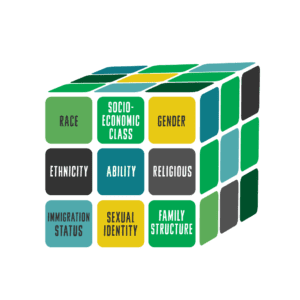অন্তর্নিহিত পক্ষপাত
শিক্ষায় কাঠামোগত বর্ণবাদ এবং বৈষম্য ভালভাবে নথিভুক্ত করা হয়েছে। অক্ষমতা এবং অন্যান্য সামাজিক পরিচয় যেমন জাতি এবং লিঙ্গের ছেদ-বিষয়কতা সম্পর্কে কম গবেষণা বিদ্যমান। যাইহোক, আইসিটি ক্লাসরুমের মধ্যে গতিশীলতা সম্পর্কে আমাদের বোঝার জন্য এই বিষয়টি অত্যন্ত গুরুত্বপূর্ণ।
One of the reasons that the intersectionality of disability and other social identities is less researched may be that within the educational systems, decision-makers who usually have a lot of discretion often believe that they are acting objectively based on facts. However, research shows that অন্তর্নিহিত পক্ষপাত—that is, attitudes or stereotypes that affect our understanding and actions in an unconscious manner—exist in all aspects of education and disability diagnosis (identification, placement, and discipline).
Racial Implicit Bias and Disability Diagnosis
 ঘড়ি: Why Is Disability Representation So White?
ঘড়ি: Why Is Disability Representation So White?
(Note: The presenter speaks quickly, particularly during a montage within the video. You can press the settings icon on the bottom right-hand corner of the screen to choose a slower playback speed.)
Racial bias and white supremacy can lead to misdiagnosis, over-diagnosis of specific types of disabilities, and under-diagnosis of others. এই নিবন্ধে সাদা আধিপত্য সংস্কৃতি সম্পর্কে আরও পড়ুন.
Studies have shown that Black and other minority students are
- more likely to be misdiagnosed;
- more likely to be educated in restrictive environments as opposed to the least restrictive environment called for by the Individuals With Disabilities Act (IDEA);
- likely to be over-diagnosed in high-incident categories of disability (which are more subjective) and under-diagnosed in low-incident categories (which are more objective).
বস্তুনিষ্ঠ প্রতিবন্ধী রোগ নির্ণয়ের সঙ্গে অসম্পূর্ণভাবে উচ্চ সংখ্যক কৃষ্ণাঙ্গ শিক্ষার্থী বস্তুনিষ্ঠ রোগ নির্ণয় একটি স্পষ্ট নির্দেশক যে কিভাবে একজন ছাত্রের অক্ষমতা নির্ণয়ের জন্য অন্তর্নিহিত পক্ষপাতের কারণ হতে পারে।
Gender Bias and Disability Diagnosis
নির্ণয়ের ক্ষেত্রে অন্তর্নিহিত পক্ষপাতের অন্য একটি উদাহরণে, গবেষণা দেখায় যে মহিলাদের প্রায়শই চিকিৎসা গবেষণা থেকে বাদ দেওয়া হয়েছে এবং প্রায়শই ভুল নির্ণয় করা হয়। এর একটি সাধারণ উদাহরণ হল মহিলাদের মধ্যে অটিজম রোগ নির্ণয়, যা গবেষণার অভাবের সাথে যুক্ত।
“The percentage served under IDEA who received services for autism was higher for male students (13 percent) than for female students (5 percent).”
—শিক্ষাগত পরিসংখ্যানের জাতীয় কেন্দ্র
Author Maya Dusenbery spoke at the Society to Improve Diagnosis in Medicine Conference about the impact of implicit bias on women’s health stemming from two major gaps: a “knowledge gap” and a “trust gap.” In the article “Women More Often Misdiagnosed Because of Gaps in Trust and Knowledge,” Liz Seegert shares Dusenbery’s ideas from the conference. Dusenbery explained, “There’s a general lack of knowledge about women’s symptoms, bodies, and conditions that disproportionately affect them. That’s the legacy of decades of women being underrepresented or excluded from the research.”
Dusenbery went on to note that “there’s a lack of trust in women’s self-reports about what they’re experiencing, and a tendency to dismiss or psychologize complaints. That is part of the broader cultural stereotypes about women, and in particular, the হিস্টিরিয়ার সংঘাত, whose explanations ranged from a ‘wandering womb’ to demonic possession to witchcraft. Once Freud entered the picture at the end of the 19th century, hysteria became a catch-all psychological explanation for these unexplained complaints, which manifested as physical symptoms.”
Implicit Bias and Consequences in the Classroom
ছাত্রদের একবার নির্ণয় করা হয়েছে ফলাফল এছাড়াও আছে. উদাহরণস্বরূপ, নির্ণয় করা অক্ষমতা সহ ছাত্রদের স্থগিত এবং বহিষ্কার করার উচ্চ হার রয়েছে।
“Nearly 75 percent of special education students were suspended or expelled at least once.”
—Dustin Rynders, “Battling Implicit Bias in the IDEA to Advocate for African American Students With Disabilities”
Keeping in mind that during the 2018–19 school year, more than seven million students in the United States of America received special education services, we can begin to sense the grand scale of implicit bias and lack of awareness of how intersectionality can impact students with disabilities in ICT classrooms. Often the implicit biases held by classroom educators and administrators can compound upon one another, which can have consequences beyond students’ K-12 education.
Going back to the analogy of the Rubik’s Cube, consider that this resource has only cited very briefly how implicit biases often play out in diagnosis and treatment with two of so many possible identities.
 শিখুন
শিখুন প্রতিফলিত করা
প্রতিফলিত করা এক্সপ্লোর করুন
এক্সপ্লোর করুন



